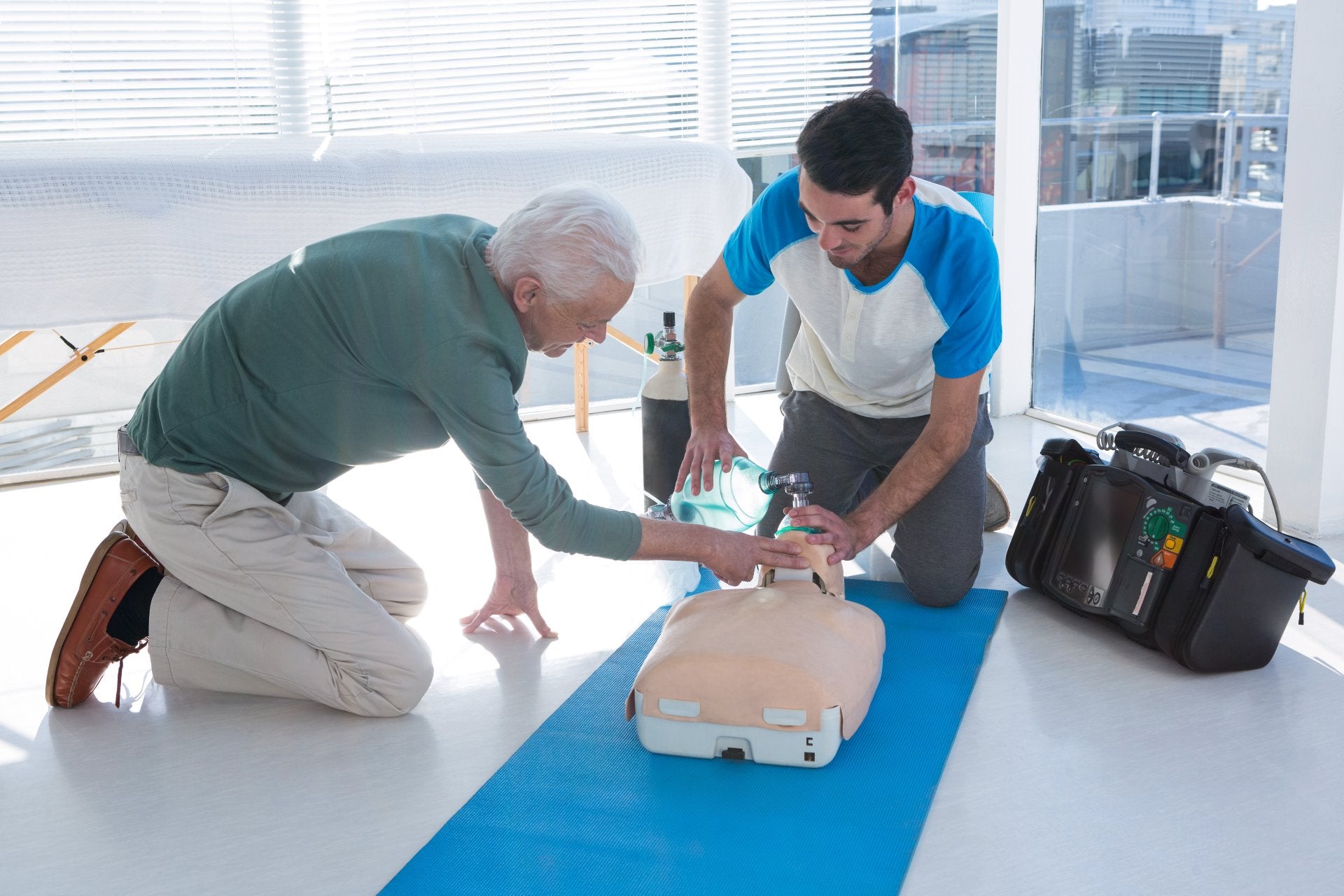Resuscitation training requirements for dental practices
Why resuscitation training is essential for dental professionals
By Dr Richard Dune

Image by LightFieldStudios via Envato Elements
In the fast-paced environment of dental practices, patient emergencies can arise without warning, making resuscitation training essential for all dental professionals. As recommended by the Resuscitation Council UK (RCUK), the General Dental Council (GDC), and the Care Quality Commission (CQC), this training ensures that dental teams have the skills and confidence to respond swiftly to life-threatening situations. Covering both adult and paediatric Basic Life Support (BLS), resuscitation training aligns with the latest regulations, creating safer dental care settings and potentially saving lives.

Image by ASphotostudio via Envato Elements
Understanding resuscitation training levels
The RCUK defines resuscitation training across three levels, each tailored to varying responsibilities within healthcare environments, including dental practices:
- Level 1 - Basic Resuscitation Skills for non-clinical staff, including receptionists, who may need to assist by alerting emergency services or retrieving equipment.
- Level 2 - BLS skills for clinical staff responsible for direct patient care, such as dentists and dental nurses, covering adult and paediatric resuscitation.
- Level 3 - Immediate Life Support (ILS) for advanced roles, although generally beyond the scope of primary care dentistry, ensures deeper intervention capabilities in settings that may require higher levels of care.
For dental teams, Level 1 and Level 2 BLS training remains crucial. These levels empower team members to recognise emergencies, initiate CPR, use Automated External Defibrillators (AEDs), and support patients while awaiting emergency medical services.
A broad skill set for diverse emergencies
Dental professionals encounter a variety of emergencies, including syncope, anaphylaxis, angina, choking, and hypoglycaemia. Resuscitation training equips dental teams with the following core skills to manage such emergencies:

Image by DC_Studio via Envato Elements

Image by DC_Studio via Envato Elements
Myths and facts about resuscitation in dental practices
Despite advances in training, certain myths continue to persist within dental settings. Addressing these misconceptions fosters a more prepared and proactive approach to emergency care.
- Myth - "Cardiac arrests are rare in dental practices, so intensive resuscitation training isn’t necessary."
- Fact - Emergencies like cardiac arrest, syncope, or anaphylaxis can happen anywhere. Comprehensive BLS training prepares staff for these unpredictable events, reducing intervention time.
- Myth - "Only dentists need resuscitation training; administrative staff don’t need to participate."
- Fact - According to the GDC and RCUK, all team members, including non-clinical staff, should know how to summon help, locate emergency equipment, and follow basic protocols.
- Myth - "Paediatric BLS is only necessary if we treat children regularly."
- Fact - Even occasional paediatric cases require staff proficiency in paediatric BLS. This training could be critical in saving a young patient’s life.
Compliance with UK standards - Key regulatory requirements
In the UK, the GDC, CQC, and RCUK provide clear guidelines for resuscitation training, creating a regulatory framework that dental practices must follow. Each body emphasises specific aspects to ensure dental teams remain competent, equipped, and compliant:

Image by towfiqu98 via Envato Elements

Image by LightFieldStudios via Envato Elements
The role of resuscitation training in quality assurance
Incorporating resuscitation training into a practice’s quality assurance strategy supports patient safety and prepares teams for high-stakes scenarios. Regular training fosters a safety culture, ensuring team members remain confident, aware, and ready to intervene. Effective quality assurance initiatives include:
- Weekly equipment checks - RCUK guidelines recommend routine checks for expiry dates on emergency medicines, AED batteries, oxygen availability, and other vital items.
- Audits and incident reviews - Regular audits and simulated incident reviews help identify gaps in preparedness, allowing practices to update policies and improve response protocols.
- Continuous skill assessment - Annual skill assessments, scenario-based practice sessions, and case study reviews to ensure all staff members are competent in BLS and emergency response.
How resuscitation training benefits dental teams and patients
Resuscitation training doesn’t just fulfil regulatory obligations—it also provides tangible benefits that enhance patient trust, safety, and team confidence:
- Building team cohesion - When dental teams practice together, they develop a cohesive approach to emergencies. Regular training drills improve communication, foster confidence, and clarify roles during critical moments.
- Patient safety - A well-prepared team reduces the likelihood of adverse outcomes during emergencies, protecting patients’ health and contributing to a positive, safe care environment.
- Professional development - By offering CPD credits, BLS training encourages continuous learning among staff, promoting a higher standard of care and a proactive attitude towards patient safety.

Image by DC_Studio via Envato Elements

Image by DC_Studio via Envato Elements
Implementing effective resuscitation training
Building a resuscitation training programme that meets both regulatory standards and clinical needs requires a structured approach. Key components include:
Anaphylaxis, choking, and DNACPR - Addressing specific scenarios
While BLS remains a cornerstone of resuscitation training, certain scenarios—such as anaphylaxis, choking, and Do Not Attempt Cardiopulmonary Resuscitation (DNACPR) considerations - require specialised knowledge and training.
- Anaphylaxis - Dental teams must swiftly recognise anaphylactic reactions, administer adrenaline, and follow emergency protocols. Training includes recognising early symptoms and preparing for emergency intervention with anaphylaxis kits.
- Choking management - Training should cover appropriate choking interventions in adults and children. Skills in abdominal thrusts, chest thrusts, and back blows are essential.
- DNACPR protocols - Understanding DNACPR orders and anticipatory care decisions is critical, especially in scenarios involving patients with known comorbidities or advanced care plans. Training equips staff to handle DNACPR conversations respectfully, ensuring that decisions align with patient wishes.

Image by halfpoint via Envato Elements

Image by rfaizal707 via Envato Elements
Creating a culture of preparedness
Effective resuscitation training isn’t solely about skills - it’s about embedding a culture of preparedness within the dental practice. This mindset ensures that each team member understands their role, the equipment is accessible, and the team is unified in their response approach. A culture of preparedness encourages vigilance, open communication, and readiness to act, making a tangible difference when emergencies strike.
Looking ahead - The future of resuscitation training in dentistry
As dental practices evolve, so too will resuscitation training. Innovations in training delivery, such as virtual reality (VR) simulations, could enhance hands-on practice, providing realistic scenarios in a controlled, immersive setting. Increased integration of interactive online modules and regular competency assessments will help dental teams maintain high standards in resuscitation skills. Furthermore, as regulations continue to adapt, dental practices must stay informed about updates to ensure compliance and uphold the highest level of patient care.

Image by Pressmaster via Envato Elements

Image by JosieElias via Envato Elements
Conclusion - A call to action
The importance of resuscitation training in dental practices cannot be overstated. For dental professionals, staying compliant with GDC, RCUK, and CQC guidelines ensures regulatory adherence and a commitment to patient safety. Each training session reinforces skills, each scenario-based practice builds confidence, and each audit improves readiness. By fostering a culture of preparedness and promoting continuous learning, dental practices can make a life-saving difference, delivering care that prioritises competence and compassion.
Investing in comprehensive, regular resuscitation training is essential for dental teams looking to stay prepared and protect their patients. In the words of the Resuscitation Council UK, “early and effective resuscitation saves lives”—a principle that every dental professional should be empowered to uphold. For more information on our tailored training programmes, visit The Mandatory Training Group to learn more.
Understanding resuscitation training levels

Image by ASphotostudio via Envato Elements
The RCUK defines resuscitation training across three levels, each tailored to varying responsibilities within healthcare environments, including dental practices:
- Level 1 - Basic Resuscitation Skills for non-clinical staff, including receptionists, who may need to assist by alerting emergency services or retrieving equipment.
- Level 2 - BLS skills for clinical staff responsible for direct patient care, such as dentists and dental nurses, covering adult and paediatric resuscitation.
- Level 3 - Immediate Life Support (ILS) for advanced roles, although generally beyond the scope of primary care dentistry, ensures deeper intervention capabilities in settings that may require higher levels of care.
For dental teams, Level 1 and Level 2 BLS training remains crucial. These levels empower team members to recognise emergencies, initiate CPR, use Automated External Defibrillators (AEDs), and support patients while awaiting emergency medical services.
A broad skill set for diverse emergencies

Image by DC_Studio via Envato Elements
Dental professionals encounter a variety of emergencies, including syncope, anaphylaxis, angina, choking, and hypoglycaemia. Resuscitation training equips dental teams with the following core skills to manage such emergencies:
Myths and facts about resuscitation in dental practices

Image by DC_Studio via Envato Elements
Despite advances in training, certain myths continue to persist within dental settings. Addressing these misconceptions fosters a more prepared and proactive approach to emergency care.
- Myth - "Cardiac arrests are rare in dental practices, so intensive resuscitation training isn’t necessary."
- Fact - Emergencies like cardiac arrest, syncope, or anaphylaxis can happen anywhere. Comprehensive BLS training prepares staff for these unpredictable events, reducing intervention time.
- Myth - "Only dentists need resuscitation training; administrative staff don’t need to participate."
- Fact - According to the GDC and RCUK, all team members, including non-clinical staff, should know how to summon help, locate emergency equipment, and follow basic protocols.
- Myth - "Paediatric BLS is only necessary if we treat children regularly."
- Fact - Even occasional paediatric cases require staff proficiency in paediatric BLS. This training could be critical in saving a young patient’s life.
Compliance with UK standards - Key regulatory requirements

Image by towfiqu98 via Envato Elements
In the UK, the GDC, CQC, and RCUK provide clear guidelines for resuscitation training, creating a regulatory framework that dental practices must follow. Each body emphasises specific aspects to ensure dental teams remain competent, equipped, and compliant:
The role of resuscitation training in quality assurance

Image by LightFieldStudios via Envato Elements
Incorporating resuscitation training into a practice’s quality assurance strategy supports patient safety and prepares teams for high-stakes scenarios. Regular training fosters a safety culture, ensuring team members remain confident, aware, and ready to intervene. Effective quality assurance initiatives include:
- Weekly equipment checks - RCUK guidelines recommend routine checks for expiry dates on emergency medicines, AED batteries, oxygen availability, and other vital items.
- Audits and incident reviews - Regular audits and simulated incident reviews help identify gaps in preparedness, allowing practices to update policies and improve response protocols.
- Continuous skill assessment - Annual skill assessments, scenario-based practice sessions, and case study reviews to ensure all staff members are competent in BLS and emergency response.
How resuscitation training benefits dental teams and patients

Image by DC_Studio via Envato Elements
Resuscitation training doesn’t just fulfil regulatory obligations—it also provides tangible benefits that enhance patient trust, safety, and team confidence:
- Building team cohesion - When dental teams practice together, they develop a cohesive approach to emergencies. Regular training drills improve communication, foster confidence, and clarify roles during critical moments.
- Patient safety - A well-prepared team reduces the likelihood of adverse outcomes during emergencies, protecting patients’ health and contributing to a positive, safe care environment.
- Professional development - By offering CPD credits, BLS training encourages continuous learning among staff, promoting a higher standard of care and a proactive attitude towards patient safety.
Implementing effective resuscitation training

Image by DC_Studio via Envato Elements
Building a resuscitation training programme that meets both regulatory standards and clinical needs requires a structured approach. Key components include:
Anaphylaxis, choking, and DNACPR - Addressing specific scenarios

Image by halfpoint via Envato Elements
While BLS remains a cornerstone of resuscitation training, certain scenarios—such as anaphylaxis, choking, and Do Not Attempt Cardiopulmonary Resuscitation (DNACPR) considerations - require specialised knowledge and training.
- Anaphylaxis - Dental teams must swiftly recognise anaphylactic reactions, administer adrenaline, and follow emergency protocols. Training includes recognising early symptoms and preparing for emergency intervention with anaphylaxis kits.
- Choking management - Training should cover appropriate choking interventions in adults and children. Skills in abdominal thrusts, chest thrusts, and back blows are essential.
- DNACPR protocols - Understanding DNACPR orders and anticipatory care decisions is critical, especially in scenarios involving patients with known comorbidities or advanced care plans. Training equips staff to handle DNACPR conversations respectfully, ensuring that decisions align with patient wishes.
Creating a culture of preparedness

Image by rfaizal707 via Envato Elements
Effective resuscitation training isn’t solely about skills - it’s about embedding a culture of preparedness within the dental practice. This mindset ensures that each team member understands their role, the equipment is accessible, and the team is unified in their response approach. A culture of preparedness encourages vigilance, open communication, and readiness to act, making a tangible difference when emergencies strike.
Looking ahead - The future of resuscitation training in dentistry

Image by Pressmaster via Envato Elements
As dental practices evolve, so too will resuscitation training. Innovations in training delivery, such as virtual reality (VR) simulations, could enhance hands-on practice, providing realistic scenarios in a controlled, immersive setting. Increased integration of interactive online modules and regular competency assessments will help dental teams maintain high standards in resuscitation skills. Furthermore, as regulations continue to adapt, dental practices must stay informed about updates to ensure compliance and uphold the highest level of patient care.
Conclusion - A call to action

Image by JosieElias via Envato Elements
The importance of resuscitation training in dental practices cannot be overstated. For dental professionals, staying compliant with GDC, RCUK, and CQC guidelines ensures regulatory adherence and a commitment to patient safety. Each training session reinforces skills, each scenario-based practice builds confidence, and each audit improves readiness. By fostering a culture of preparedness and promoting continuous learning, dental practices can make a life-saving difference, delivering care that prioritises competence and compassion.
Investing in comprehensive, regular resuscitation training is essential for dental teams looking to stay prepared and protect their patients. In the words of the Resuscitation Council UK, “early and effective resuscitation saves lives”—a principle that every dental professional should be empowered to uphold. For more information on our tailored training programmes, visit The Mandatory Training Group to learn more.
About the author
Dr Richard Dune
With over 20 years of experience, Richard blends a rich background in NHS, the private sector, academia, and research settings. His forte lies in clinical R&D, advancing healthcare tech, workforce development and governance. His leadership ensures regulatory compliance and innovation align seamlessly.

About the author
Dr Richard Dune
With over 20 years of experience, Richard blends a rich background in NHS, the private sector, academia, and research settings. His forte lies in clinical R&D, advancing healthcare tech, workforce development and governance. His leadership ensures regulatory compliance and innovation align seamlessly.

Related blog articles
View allContact us
Complete the form below to find out how we can help your organisation with regulatory compliance and governance, statutory and mandatory training, continuous professional development, learning management systems and educational technologies.




